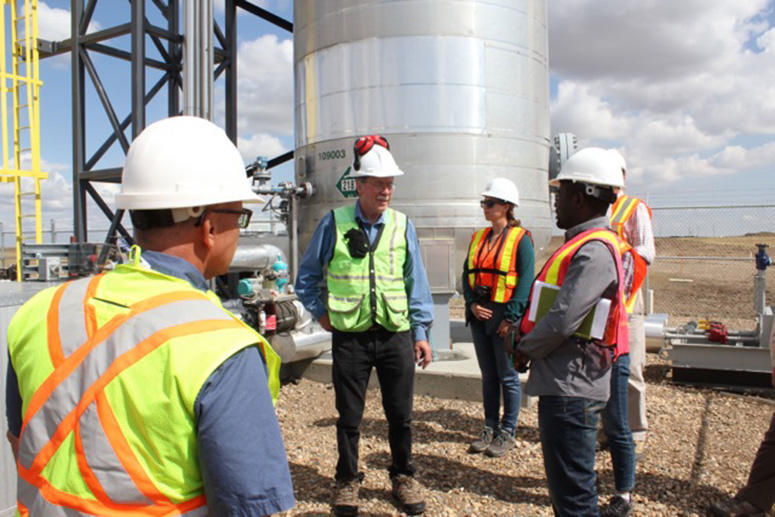Oct. 25, 2017
Unique-in-the-world carbon capture and storage Field Research Station opens

Don Lawton, director of CaMI, and professor of geophysics speaks to Field Research Station visitors.
Ruth Klinkhammer, Carbon Management Canada Research Institutes
A decade of planning, a significant investment in leading-edge research infrastructure, and a careful fostering of partnerships with government and industry culminated this week in the official opening of the Containment and Monitoring Institute’s carbon capture and storage Field Research Station located in Newell County in southern Alberta.
The research station — a partnership between CMC Research Institutes and the University of Calgary — offers a unique site to develop and demonstrate technologies to detect and monitor C02 and other fluids stored in underground reservoirs. It also aligns with the university’s commitment to a low-carbon future and its emergence as a leader in carbon capture and storage research.
“This field station is unique worldwide,” says Don Lawton, director of the Containment and Monitoring Institute (CaMI) and professor of geophysics in the Faculty of Science. “We are establishing technologies to track the movement of carbon dioxide, and validate it is stored safely. Our goal is to find the best technologies to ensure that after injecting CO2 it doesn’t bubble up, but stays underground and we know where it is.”
“The University of Calgary is committed to a low carbon future, so we’ve invested in partnerships with industry and government to bring new knowledge to market,” says Ed McCauley, vice-president (research). “The Field Research Station provides an unparalleled opportunity to field-test concepts at scale, which will accelerate the development and commercialization of carbon capture and monitoring solutions.”
Monitoring and tracking carbon dioxide at intermediate depths
Carbon dioxide emissions are a major contributor to climate change. They are in part the result of oil production, the burning of fossil fuels and the generation of electricity and heat. Carbon storage is a critical part of international carbon reduction scenarios. The new field research station will test and measure the efficacy and reliability of those carbon capture and storage technologies.
The 200-hectare CaMI field research station provides the step between modelling work that can be done on a bench scale and a full-scale field pilot. At the site, small amounts of CO2 will be injected into a reservoir 300 metres underground, where the CO2 remains a gas (it turns liquid at greater depths). The injection well at the site is surrounded by two observation wells and four water-monitoring wells to allow researchers to test a variety of technologies.
In the field, reservoirs into which CO2 is injected for storage are typically very deep — from 1.5 to 2.5 kilometers below the surface. But while we know a lot about how to measure CO2 in the atmosphere and in the soil, Lawton says the big gap in knowledge is what happens when CO2 might migrate upward into rocks and intermediate zones. “The field station will look at those intermediate depths,” he says. “We are injecting at 300m not to see how much we can store, but to understand how CO2 moves through rocks, to test early warning system to minimize climate and groundwater impact.”

From left: Don Lawton, speaking; Sandra Odendahl; Ed McCauley; Paul Fulton.
Riley Brandt, University of Calgary
Collaborative partnerships and emerging expertise
The University of Calgary is an emerging player in carbon capture and storage research. In addition to the newly commissioned field station, this September five of the university’s top energy researchers attended the Carbon Capture, Utilization, and Storage Experts’ Workshop in Houston, Texas. In addition to CaMI’s Don Lawton, attendees included biogeoscientist Marc Strous and seismologist David Eaton — who were both panellists — as well as energy technology researcher Joule Bergerson and chemist George Shimizu.
As part of training the next generation of energy research scientists, the CaMI facility will host a field school in summer of 2018 for 15 to 20 graduate students from the University of Calgary and students from instutions in Norway and the Netherlands. They will do research and training on reservoir engineering, geophysics, and monitoring carbon dioxide injected at the CaMI research station.
The CaMI field research station received funding from the federal Western Economic Diversification Program, and the current operation of the FRS is currently funded through the University of Calgary’s Canada First Excellence Research Fund (CFREF) initiative ‘Global Research Initiative in Sustainable Low Carbon Unconventional Resources’ and CMC Research Institutes. CaMI also offers a subscription-based access to monitoring research outcomes from the field research station. Current joint industry partners include: Statoil, Shell Global Solutions, RITE Japan, and Cenovus Energy.
Located in the heart of Canada’s energy sector, the University of Calgary has built a reputation as a global leader in energy research and innovation. With a focus on our low-carbon future, diverse teams are also assessing the effects of energy-related processes while harnessing unconventional hydrocarbon resources through the Energy Innovations for Today and Tomorrow research strategy.
